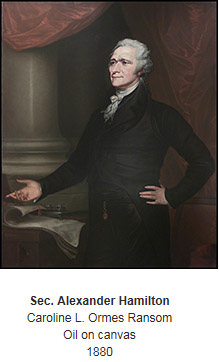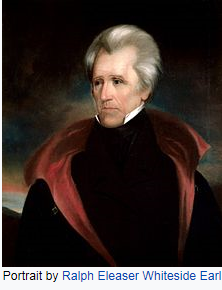Lessons for the Euro From Early American Monetary and Financial History by Jeffry Frieden
History does not repeat itself, but it does rhyme. – Mark Twain
Welche Parallelen lassen sich zwischen der Europäischen Union und der Finanzgeschichte der USA ziehen? Die Staaten damals waren wirtschaftlich ebenso unterschiedlich entwickelt wie die Mitglieder der Europäischen Union heute. Es kann daher nicht die eine Finanzpolitik geben, die für alle past. Damals wie heute entscheidend ist aber das Vertrauen in Institutionen wie die EZB. Hier meine Stichpunkte zu der spannenden Gegenüberstellung von Jeffry Frieden. Den Link zum vollständigen Essay bei scribd findet ihr ganz unten.
- expansionary monetary and credit conditions: low interest rates, relatively lax regulatory standards, aggressive government spending, typically favored in rapidly growing areas, they want to be able to expand their activities more easily to take advantage of new opportunities, economic agents are often debtors, whose real debt burden is lessened by lower real interest rates
- in more stable regions of the economy there are more likely avers and creditors, they want less expansionary monetary policies and lower inflation, they prefer more pro-creditor financial policies and more limited government spending
- the American Revolution was financed largely by the issuance of debt that could not be serviced and through money that could not be redeemed – by inflationary means
- the Continental Congress, which was the representative agent of the thirteen colonies, issued a currency called the Continental Dollar. This paper money is best known in the context of the expression
worthless as a Continental
- most of what circulated in this period was foreign currency, especially Spanish silver dollars, the famous ‘pieces of eight’, whose common use explains why Americans still talk in terms of ‘bits’, such as two bits being two-eights (one-quarter) of the Spanish dollar; the Continental currency was indeed essentially worthless, and with the Constitution adopted, the new administration of President George Washington had to face the problems associated with the absence of monetary credibility
1789
- in 1789, President Washington appointed Hamilton, his principal aide during the War for Independence, as the country’s first Secretary of the Treasury

- Hamilton argued, that a national debt, if it is not excessive, will be to us a national blessing… a powerful cement of our Union; he recognised that the country’s lack of creditworthiness posed an impediment to financial independence
…to be able to borrow upon good terms, it is essential that the credit of a nation should be well established… States, like individuals, who observe their engagements, are respected and trusted: while the reverse is the fate of those, who pursue an opposite conduct. – Alexander Hamilton
- while the debts in default stood in the way of being “able to borrow upon good terms”, these were mostly debts of individual states, not of the new Federal government; Hamilton proposed to have the Federal government recognise the state debts and exchange them for Federal obligations, which would be serviced; this meant that the Federal governments would assume the debts of the several states and pay them off at something approaching face value; Continentals would be redeemed at a penny on the dollar; the arrangement was known as ‘Assumption’, because the federal government ‘assumed’, or took on, the states’ debts
- a centralisation of power would give the Federal government unprecedented authority in financial matters; the federal government regained access to international and domestic financial markets
- Hamilton: In countries in which the national debt is properly funded, and an object of established confidence, it answers most of the purposes of money; in addressing the monetary aspect of the problem, Hamilton proposed a central bank; he called for the establishment of the Bank of the United States, patterned largely on the Bank of England.
- the tendency of a national bank is to increase public and private credit; the former gives power to the state, for the protection of its rights and interests and the latter facilitates and extends the operations of commerce among individuals
1791
- the bank typically called the First Bank opened for business in 1791 in Philadelphia; the Bank of the United States acted in many ways like a typical centralbank of the era; it had the right to issue notes, and although it did not have a monopoly on note issuance, eventually its banknotes became the effective legal tender of the United States; it acted as the fiscal agent of the Federal government, which also held equity in the bank, and it was responsible for domestic and international financial ties. Its size – it was one of the country’s largest corporations, and by far its biggest financial institution – meant it had a powerful impact on macroeconomic conditions
- the United States in this period was growing very rapidly; people in the most dynamically expanding regions of the country, especially in the South, believed that the policies put in place by Hamilton were limiting economic opportunity; the clash was between creditors and debtors, fiscal conservatives and expansionists
1812
- in 1812 the United States embarked upon an ill-advised war against Great Britain; the new nation did not fare well, seeing its capital city burned and effectively losing the war; in the absence of the National Bank, the Federal government had grave difficulties borrowing to finance the war effort; the end of the First Bank, in addition to its impact on public finances, led to substantial disruptions in what had become a more developed financial system
- with the end of the War of 1812 in 1815, Congress reversed courseand established a new national bank, the Second Bank of the United States; the Second Bank, chartered in 1816
- Economic conditions began changing very rapidly almost as soon as the Second Bank was founded; from 1789 to 1815, when Europe (the relevant world economy) was completely absorbed by the Napoleonic Wars, economic policy was relatively simple; American policy makers did not have much to do, especially on the external front: international capital markets were largely closed, and Continental export markets were embargoed for much of the period
1816
- after 1816 economic conditions began to change dramatically: the cotton gin, canal building, railroad
- the American frontier was booming and settlers pushed very rapidly westward; different regions of the country experienced substantial divergences in their macroeconomic conditions; this macroeconomic divergence led to what has gone down in American history as the Bank War
1832

- Andrew Jackson in 1832 vetoed the Congressional effort to re-charter the bank, if Congress has the right under the constitution to issue paper money, it was given them to be used by themselves, not to be delegated to individuals or corporations
The rich and powerful too often bend the acts of government to their selfish purposes…. – Andrew Jackson
- a couple of years later, he told supporters of the Bank:
I have been a close observer of the doings of the Bank of the United States….You have used the funds of the bank to speculate in the breadstuffs of the country. When you won, you divided the profits amongst you, and when you lost, you charged it to the bank….You are a den of vipers and thieves. I have determined to rout you out, and by the Eternal, I will rout you out! - many on the conservative wing of the Republican Party regard Andrew Jackson as their intellectual and political forefather; His anti-central bank views presaged their hostility to the Fed
The past is never dead. It’s not even past. – Andrew Jackson
- when Jackson and his supporters effectively ended the Second Bank’s ability to act as a central bank, there was no longer an institution to make effective national monetary policy; the bank had affected the growth of the money supply by dealing in the notes of state-chartered banks to ensure appropriate backing; with the bank closed, there was no central public institution to oversee the quality of banknotes
- States were now able to charter banks without the Second Bank constraining the banks’ behavior; earnings from state-chartered banks allowed some states to engage in more expansive spending; with respect to general economic conditions, expanding the number of banks typically was a way of expanding access to credit – and thus of the effective state money supply
- the Second Bank period was succeeded by an era of ‘free banking’; the easy-money frontier had won, as the peripheral states were now free to set their own bank regulations, and by extension effective monetary policies
- some banks maintained adequate reserves, but some had insufficient backing for the notes they issued; reserves were typically in state government bonds, which were of varying degrees of reliability: the banknotes of a bank with reserves in questionable state bonds were worth less than those of a bank with reliable reserves; this meant that a dollar note issued by one bank could, ineffect, be worth less than a dollar note issued by another bank; there were a variety of state currencies, all called dollars, but trading at different values depending upon how much faith people had in the backing of the banknotes issued by the state’s banks
1861
- southern resistance to Federal centralisation became irrelevant when the Southern states seceded in 1861; two years later, Congress (minus the South) passed the National Banking Act of 1863, which created a single issuer of national bank notes, the independent treasury; bank-specific banknotes required that the banks have a national charter and follow strict reserve requirements, so that the banknotes were of the banks in name only; in reality they were a national currency; and this was very relevant at the time, for the United States went off gold during the Civil War, so that it was on a fully paper fiat-currency standard at the time
1879
- it was not until 1879 that the dollar was pegged to gold at a fixed rate
AMERICAN LESSONS FOR EUROPE?
- the march from the Articles of Confederation to a national currency was protracted and difficult and it continued long after 1863 or 1879: the country did not have a central bank until the founding of the Federal Reserve in 1913
- and the full panoply of fiscal federalist spending programmes only began to operate in the 1930s, and were not fully in place until the 1970s. This need not suggest that a functioning single market in Europe will take 150 or more years to create; but it does suggest the political difficulties that will be encountered along the way
Policy-makers cannot satisfy all of the people all of the time. – Abraham Lincoln
- interests at stake can be divided between easy- and tight-money camps; on the one hand, there are those who would benefit from looser credit conditions and a weaker currency, with relatively high tolerance for inflation: farmers, manufacturers, debtors; on the other hand, there are those who want tighter money, a strong currency and low rates of inflation: the creditor classes, commercial and financial groups
⇒ there is unlikely to be one unambiguously desirable policy for all of the members of a very disparate union
- Hamilton’s reforms aimed at establishing the credibility of the central, Federal, government; Hamilton and his allies recognised the need for an authoritative, consistent approach to the new republic’s financial and monetary problems
- a continuation of the bitter sectional debates threatened the reputation of the new nation at home and abroad; the Federal government needed to establish its authority, and it did so with Assumption and the establishment of the First Bank
⇒ any union depends on the standing of its central authorities
- no matter how federal the EU becomes, it will have Union-wide policy-making institutions, and for these institutions to function they need to be seen as trustworthy; failure to resolve a union-wide problem can have serious repercussions, if it is taken to mean that the union is incapable of overcoming the more parochial concerns of its members
⇒ for any economic union to be successful, the union’s members –member states and member citizens – need to believe that the union’s institutions are capable of confronting and resolving problems more effectively than individual member states could alone
- Americans have long argued about the appropriate division of responsibility between the states and the federal government and since Hamilton, there has rarely been any doubt that the federal government is capable, at least in principle, of resolving problems that the individual states could not on their own
- Although the European Union is not a federal union such as the United States was trying to be, a great deal of economic policy is made at the level of the EU; one of the problems that Europe has faced in the past decade is the relative weakness of European institutions; Americans and foreigners had little reason to trust the willingness or ability of the new United States government to honour its obligations; likewise, many in Europe and elsewhere have doubts about the seriousness with which EU and euro-area commitments can be taken; just as Hamilton and the Americans had to establish the authority and reliability of the central, Federal, government, the leaders of the European Union, and of its member states, have to establish the trust-worthiness of the EU’s institutions
⇒ the record of the past ten years points to an apparent inability of the region’s political leaders to arrive at a conclusive resolution of the debt crisis that has bedeviled Europe since 2008
- in the American case, the country dealt with these linked problems over a sixty-year period; assumption established the seriousness of the central government, but also created moral hazard; the refusal to assume the debts of defaulting states in the 1840s established the credibility of the Federal government’s no-bailout commitment; Europe today faces both of these problems, and the attempt to resolve them simultaneously has so far failed; proposals to restructure debts are rejected as creating too much moral hazard, but the inability to come up with a serious approach to unsustainable debts has sapped the EU of most of its political credibility
- both aspects of central policy are essential: the central authorities must instil faith in the credibility of their commitments, and do so without creating unacceptable levels of moral hazard; this is not to suggest that the European Union should assume the debts of its member states; Europe’s national governments have far greater capacity, and far greater resources, than did the nascent American states; but the lack of credibility of Europe’s central institutions is troubling, and is reminiscent of the poor standing of the new United States before 1789
- a political monetary policy is a meaningless chimera, as are a political monetary policy institutions; central banks are created by governments, in order to carry out the desires of elected politicians; in extremis they can be reined in by governments– or, as in the early American experience, shut down by them; the notion that a written rule will somehow insulate a monetary authority from all of a country’s, or a region’s, political realities has no basis in theory, history or current experience
- the European Central Bank seems quite cognisant of its responsibilities to the variegated constituencies of the euro area but some member states seem to believe that any consideration of political realities is inappropriate; this is usually coupled with an insistence that the ECB bend to the political realities of the member state in question
- creditor countries with large communities of savers complain bitterly and criticise the ECB about the losses their people are suffering; but a hint from a debtor country of the need for more aggressive policies to lighten the burden of accumulated debts is met with howls about the independence of the central bank
Monetary policy, like all policies, creates winners and losers; it is likely to impede the proper functioning of the central bank itself; the reasons are not technical: it is not too much of an exaggeration that Alexander Hamilton had a technical solution to all of them; he knew how to create a functioning federal union with a common monetary and financial policy, and a stable fiscal regime; however, his creations turned out to be politically unsustainable and political realities eventually undermined his achievements; only after 80 years and a civil war did the country devise politically sustainable compromises, and even these were subject to continual challenges for another 80 years.

Schreibe einen Kommentar